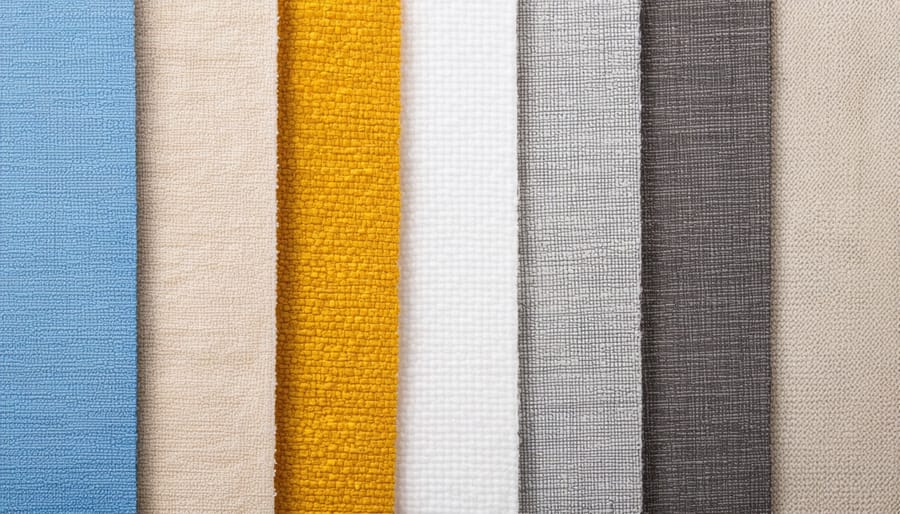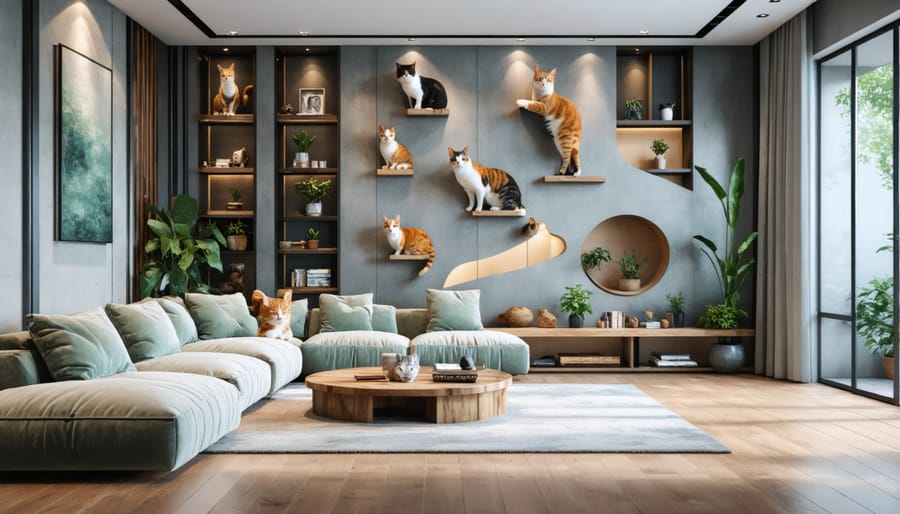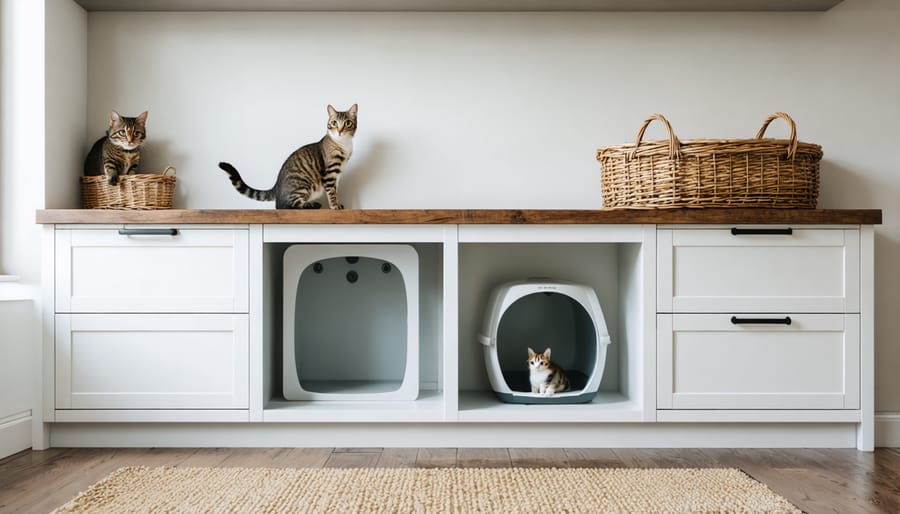Transform your living space into a pet paradise without sacrificing style by integrating smart design solutions that work for both you and your furry family members. Modern pet-friendly interior design goes far beyond basic pet beds and scratching posts – it’s about creating a harmonious environment where elegant aesthetics meet practical pet functionality.
Think elevated cat walkways disguised as floating shelves, custom-built window seats that double as cozy pet nooks, and stylish storage solutions that keep pet supplies organized yet accessible. Today’s innovative designers are revolutionizing how we approach pet-inclusive spaces, proving that pet-friendly homes can be both sophisticated and functional.
Whether you’re planning a complete home renovation or looking to make pet-friendly updates to your existing décor, this guide will show you how to create a space that delights both two-legged and four-legged residents. From durable, pet-proof materials to clever architectural elements that celebrate your pets’ natural behaviors, discover how to design a home that’s both beautiful and perfectly tailored to your pets’ needs.
Smart Flooring Choices That Stand Up to Paws
Best Materials for Pet-Proof Floors
When it comes to creating a pet-friendly home that’s both stylish and durable, choosing the right flooring material is crucial. Luxury Vinyl Planks (LVP) lead the pack as an excellent choice, offering exceptional scratch resistance and waterproof properties while mimicking the beauty of hardwood. This versatile option aligns perfectly with modern sustainable home solutions and comes in various styles to match any décor.
Porcelain or ceramic tile is another fantastic option, providing unmatched durability against pet claws and accidents. These materials are nearly impossible to scratch, extremely easy to clean, and stay cool in warm weather – a bonus for your furry friends. Consider larger tiles to minimize grout lines, making maintenance even easier.
For those who love the warmth of natural materials, cork flooring offers a unique combination of comfort and resilience. It’s naturally antimicrobial, water-resistant, and provides excellent traction for pets. The material’s slight give helps reduce joint stress for both pets and humans.
Polished concrete has gained popularity for its industrial-chic appeal and incredible durability. When properly sealed, it resists scratches, stains, and odors while being incredibly easy to maintain. Just add some cozy area rugs for pet comfort zones.
Remember to avoid soft woods and traditional hardwoods, as they’re prone to scratching and water damage. Whatever material you choose, opt for matte or textured finishes to help conceal any minor scratches or wear patterns.
Area Rugs and Pet-Safe Solutions
Selecting the right area rug when you have pets requires a perfect balance of style and practicality. opt for rugs made from durable, stain-resistant materials like indoor/outdoor polypropylene, sisal, or solution-dyed acrylic. These materials not only withstand pet traffic but also resist moisture and odors while maintaining their aesthetic appeal.
Consider patterns and colors that help conceal pet hair and occasional accidents. Medium-toned rugs with subtle patterns or geometric designs are excellent at masking fur and small stains. Dark solids, while tempting, tend to show light-colored pet hair more prominently, while very light rugs can show everything.
When it comes to texture, low-pile rugs are your best friend. They’re easier to clean, less likely to trap pet hair, and more resistant to claw snags than high-pile alternatives. If you have cats who love to scratch, avoid loop pile rugs as they can catch claws and unravel.
Don’t forget about rug pads! They’re essential for preventing slipping and providing extra cushioning for both pets and humans. Look for non-toxic, pet-safe options that won’t release harmful chemicals into your home.
Pro tip: Consider using washable rugs in high-traffic pet areas. Many modern companies offer stylish, machine-washable options that make maintenance a breeze while keeping your space looking fresh and inviting.
Pet-Friendly Furniture Selection
Fabric Choices That Repel Pet Hair
When it comes to living with pets, choosing the right fabrics for your furniture can make a world of difference. Tight-weaved materials like microfiber and synthetic velvet are excellent choices, as pet hair slides right off instead of getting embedded in the fabric. These materials are also incredibly durable and easy to clean with just a quick wipe.
Leather and faux leather are particularly pet-friendly options, especially for dog owners. Not only do they repel pet hair effectively, but they’re also resistant to odors and can be easily wiped clean of muddy paw prints. If you’re worried about scratches, opt for distressed leather which tends to hide wear and tear better than smooth varieties.
For a more traditional look, consider treated cotton or canvas with a tight weave. These fabrics can be specially treated with stain-resistant finishes, making them both practical and stylish. Another great option is outdoor fabric brought indoors – these materials are designed to withstand tough conditions and usually feature tight weaves that resist pet hair.
Avoid materials like velvet, chenille, and loose-weave fabrics, as they tend to trap pet hair and are more challenging to clean. Also, steer clear of delicate silks and linens, which can easily show wear and damage from pet activity.

Clever Furniture Arrangements
Arranging furniture with pets in mind can make your home more harmonious for both two-legged and four-legged family members. Start by creating clear pathways through your living spaces, ensuring your pets have easy routes to their essential areas like food bowls, beds, and litter boxes. A good rule of thumb is to maintain at least 3 feet of walking space in main traffic areas.
Consider positioning larger pieces like sofas and cabinets against walls to maximize open floor space and prevent your pets from feeling cornered. If you have cats, leave some vertical spaces between furniture pieces to create natural climbing and perching opportunities. For dogs, avoid placing furniture in configurations that might encourage running and roughhousing in delicate areas.
Place pet beds and resting spots in quiet corners with good visibility of the room, satisfying their need to keep watch while staying cozy. If possible, position furniture to create designated pet zones away from high-traffic areas. This helps reduce anxiety and prevents accidents during busy household moments.
Remember to anchor tall furniture pieces to prevent tipping, especially if you have climbing cats or large dogs who might lean against them. Strategic furniture placement can also help minimize pet hair accumulation by reducing the number of surfaces where it can collect.

Creative Pet Spaces That Blend With Decor
Stylish Pet Bed Integration
Gone are the days when pet beds meant unsightly plastic cushions tucked away in corners. Today’s pet beds can be seamlessly integrated into your home’s design, becoming stylish focal points that serve both your furry friend and your aesthetic vision.
Consider built-in solutions, like converting the space under a window seat or stair landing into a cozy pet nook. This approach maximizes existing space while creating a dedicated spot for your pet that looks intentional and polished. You can add custom cushions in fabrics that complement your room’s color scheme.
For a more flexible option, look for pet beds that double as furniture pieces. Modern designs include side tables with built-in pet caves underneath, or ottoman-style beds that provide both seating and a comfy spot for your pet. These dual-purpose pieces are especially valuable in smaller spaces.
Match materials and textures to your existing décor. If your room features natural elements, opt for woven rattan or wooden pet bed frames. For contemporary spaces, sleek metal or minimalist designs work beautifully. Add personality with washable cushion covers that coordinate with your throw pillows or curtains.
Position the bed thoughtfully – pets often prefer spots where they can observe household activity while feeling secure. A corner near family gathering areas or a quiet spot with a view of the room usually works well. Just be sure to keep the bed away from high-traffic areas and direct heat sources.
Hidden Litter Box Solutions
Let’s face it – litter boxes aren’t exactly the most attractive element of cat-friendly home design, but they’re essential for our feline friends. Fortunately, there are plenty of creative ways to keep these necessities out of sight while maintaining easy access for your cats.
One popular solution is converting a cabinet into a discreet litter box space. Choose a cabinet with enough height and width for your cat to move comfortably, then cut a cat-sized entrance on one side. Install a cat door for added privacy, and use the remaining cabinet space for storing supplies.
Another clever approach is incorporating the litter box into built-in furniture. Consider adding a hidden compartment under a window seat or creating a dedicated space within a closet. Just ensure proper ventilation to keep odors at bay.
For DIY enthusiasts, transforming a decorative screen or room divider into a litter box concealer offers both functionality and style. Place the screen strategically in a corner, creating a private nook for your cat while adding visual interest to the room.
Plant lovers can opt for large decorative planters with hidden compartments. These dual-purpose pieces not only hide the litter box but also bring greenery into your space. Just ensure any plants used are cat-safe and placed away from the entrance.
Remember to maintain easy access for cleaning and position these solutions in quiet areas where your cat feels comfortable.

Pet-Safe Decor and Accessories
Plant Selection and Placement
When adding greenery to your pet-friendly home, it’s crucial to choose pet-safe indoor plants that won’t harm your furry friends if they decide to take a curious nibble. Opt for pet-friendly varieties like Boston Ferns, Spider Plants, and African Violets. These not only look beautiful but are completely safe for your four-legged companions.
Strategic placement is just as important as plant selection. Keep plants elevated on sturdy stands or hang them from secure ceiling hooks to prevent pets from accessing them. Consider creating a dedicated plant corner away from your pet’s usual lounging spots. Even with safe plants, this helps minimize soil spillage and protects your plants from playful paws.
For additional protection, try surrounding floor-level plants with decorative pebbles or river rocks. This deters cats from using the soil as a litter box and adds an attractive design element to your space. Remember to regularly check plants for fallen leaves and maintain proper drainage to keep your pets safe and your home looking fresh.
Window Treatment Safety
Window treatments can pose serious safety risks for our furry friends, but with thoughtful choices and proper precautions, you can create both a stylish and safe environment. Cordless blinds and shades are your best bet, eliminating the risk of entanglement that traditional corded options present. If you already have corded window treatments, invest in cord cleats or wind-ups to keep dangerous loops well out of reach.
Consider sturdy roller shades or Roman blinds that can withstand playful batting from cats or dogs. Vertical blinds, while attractive, might not be the best choice as pets can easily bend or break the slats. For an elegant solution, opt for motorized blinds that eliminate cords entirely while adding a touch of modern convenience to your home.
Don’t forget about the window sill area – ensure any decorative elements are securely anchored and non-toxic. If your pets love gazing outside, create a dedicated “viewing station” with cushions or a pet bed placed strategically near cord-free windows. This not only keeps them safe but also protects your window treatments from wear and tear.
Storage Solutions for Pet Supplies
Keeping your pet supplies organized doesn’t mean sacrificing style for functionality. With the right creative storage solutions, you can maintain a clutter-free space while ensuring easy access to all your furry friend’s essentials.
Consider installing floating shelves near your pet’s feeding area to store treats, medications, and grooming supplies. These not only look sleek but keep important items out of your pet’s reach. For toys, try using decorative baskets or vintage crates that complement your home’s décor while providing easy access for both you and your pet.
Transform unused space under stairs or in cabinet corners into custom pet storage zones. Install pull-out drawers for food storage, or add hooks for leashes and collars. A stylish bench with hidden storage can serve as both seating and a place to keep pet beds or blankets when not in use.
Make use of vertical space by mounting pegboards or grid systems on utility room walls. These versatile options allow you to customize storage with hooks, baskets, and shelves as needed. For smaller homes, consider multi-functional furniture pieces, like ottoman storage units that can hide pet supplies while serving as comfortable seating.
Keep cleaning supplies organized in clear, labeled containers that fit neatly into cabinets or on shelves. Use mason jars for treats and stackable containers for dry food to maintain freshness while adding a touch of style to your storage setup. Remember to position frequently used items at eye level for convenience while keeping potentially harmful products safely out of reach.
Creating a pet-friendly home doesn’t mean sacrificing style or comfort. By implementing the design solutions we’ve discussed, you can create a space that both you and your furry friends will love. Remember that successful pet-friendly interior design is all about balance – combining durable materials, clever storage solutions, and dedicated pet spaces while maintaining your personal aesthetic.
Start with small changes, like adding washable throws to your furniture or creating a cozy corner for your pet’s bed. As you become more comfortable with pet-friendly design concepts, you can tackle larger projects such as installing built-in feeding stations or creating custom pet furniture that complements your decor.
The key is to think about your pet’s needs while planning your space, rather than trying to adapt your existing design later. By considering both functionality and aesthetics from the start, you’ll create a harmonious environment that works for everyone. Whether you have cats, dogs, or other pets, there’s always a way to incorporate their needs into your home’s design beautifully and effectively.
Take the first step today – your pets will thank you, and you’ll enjoy a more organized, pet-friendly living space that still reflects your personal style.
